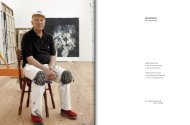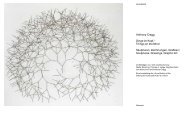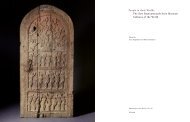Im Buch blättern (PDF)
Im Buch blättern (PDF)
Im Buch blättern (PDF)
Sie wollen auch ein ePaper? Erhöhen Sie die Reichweite Ihrer Titel.
YUMPU macht aus Druck-PDFs automatisch weboptimierte ePaper, die Google liebt.
INHALT CONTENTS<br />
8<br />
9<br />
21<br />
21<br />
28<br />
29<br />
42<br />
43<br />
65<br />
74<br />
137<br />
139<br />
146<br />
sally schöne<br />
� KERAMIK, DIE BEFREIT<br />
CERAMICS THAT LIBERATE<br />
barbara radice<br />
� HOMMAGE AN DIE KERAMIK<br />
AN HOMAGE TO CERAMIC<br />
fulvio ferrari<br />
� ETTORE SOTTSASS:<br />
MIT DER WELT IN SPANNUNG BLEIBEN<br />
ETTORE SOTTSASS:<br />
KEEP IN TENSION WITH THE WORLD<br />
hubertus adam<br />
� ETTORE SOTTSASS<br />
UND DIE KRISE DES OBJEKTS<br />
ETTORE SOTTSASS<br />
AND THE CRISIS OF THE OBJECT<br />
� ZEICHNUNGEN<br />
DRAWINGS<br />
� KERAMIK 1955 – 2000<br />
CERAMICS 1955–2000<br />
erik & petra hesmerg Fotografie_photography 2011<br />
Abbildungsnachweis_index of images<br />
Chronologie_chronology fulvio ferrari<br />
Biografie_biography
KERAMIK, DIE BEFREIT<br />
sally schöne<br />
ICH BIN ÜBERZEUGT DAVON, DASS WIR ALS DESIGNER<br />
UND ARCHITEKT DIE AUFGABE HABEN,<br />
DINGE ZU GESTALTEN, DIE DAS GLÜCK ANZIEHEN. 1<br />
� Ettore Sottsass (1917–2007) zählt zu den Protagonisten des<br />
italienischen Designs der zweiten Hälfte des 20. Jahrhunderts. Ausgebildet<br />
als Architekt, widmete er sich seit den 1950erJahren intensiv<br />
der Gestaltung von Interieurs, aber auch von Raum und Körperschmuck.<br />
Die Bandbreite der entworfenen Gegenstände reicht von<br />
Schränken, Regalen und Lampen über Büromöbel und technik bis<br />
hin zu Textilien, Glas, Metallgerät und Colliers. Nicht ohne Grund<br />
wurde und wird Sottsass häufig als „AllroundTalent“ und „Vater“ der<br />
nachfolgenden Designergeneration bezeichnet. Welch großen Raum<br />
insbesondere die Keramik in seinem Schaffen einnahm, wird bei der<br />
Darstellung seines vielgestaltigen Werkes oft marginalisiert. Zumindest<br />
müssen in der Literatur häufig einzelne Belegstücke pars pro<br />
toto für eine fast fünfzigjährige Auseinandersetzung mit dem keramischen<br />
Material stehen. 2 Auch in Ausstellungen fand die Keramik<br />
bisher nur am Rande Beachtung. So blieben vor allem die Unikate der<br />
1950er und 1960erJahre seit ihrer Entstehung in einem Mailänder<br />
Keller in Kisten verpackt. Diese Schätze zu heben und einer breiten<br />
Öffentlichkeit bekannt zu machen ist das Ziel der Düsseldorfer Ausstellung.<br />
Zur Keramik, so schrieb Sottsass, sei er zufällig gekommen. 1955 bat<br />
ihn ein amerikanischer Händler, Irving Richards, moderne Keramik<br />
zu entwerfen 3 und vermittelte Sottsass den Kontakt zu der in Montelupo<br />
Fiorentino ansässigen Keramikfirma Bitossi. 4 Mit Unterstützung<br />
des künstlerischen Direktors der Firma, Aldo Londi, setzte Sottsass<br />
seine Entwürfe um. Die ersten Produkte erwiesen sich jedoch – trotz<br />
intensiver Arbeit – als unverkäuflich.<br />
Die Frage, die Sottsass fortan in zunehmendem Maße beschäftigte,<br />
war die nach dem tieferen Sinn der Dinge. Einfach irgendwelche<br />
ziergegenstände 5 zu produzieren, die man auf Möbel stellte, erschien<br />
ihm nicht sinnvoll. Er begann die Beziehung zwischen Objekten<br />
und der Art des Umgangs mit ihnen zu hinterfragen.<br />
CERAMICS THAT<br />
LIBERATE<br />
Sottsass war fasziniert von der Keramik vergangener<br />
Kulturen in Mesopotamien und Asien. Die Artefakte<br />
aus Ton erschienen ihm wie Spiegelbilder menschlichen<br />
Seins. lest auf den keramiken, und schon<br />
wisst ihr alles. es öffnen sich die zimmer, in<br />
denen die menschen leben, essen und strei -<br />
ten, sich streicheln, in denen sie sich hinlegen<br />
und morgens aufstehen, wenn es gut geht<br />
und sie lust haben, frische luft zu atmen.<br />
seht euch die keramiken an, alles ist dort,<br />
wie in den gedichten und liedern. 6 Aus dieser<br />
Erkenntnis heraus gelangte er zu der Schlussfolgerung,<br />
dass es möglich sein müsse, Dinge zu entwerfen,<br />
mit denen man Einfluss auf die menschliche<br />
Wahrnehmung ausüben kann. ich begann daran<br />
zu denken, dass es nur sinn machen würde,<br />
objek te her zustellen, die den leuten helfen,<br />
sich auf irgendeine art zu erkennen und sich<br />
zu befreien. damit will ich sagen, dass, wenn<br />
es einen grund gibt, gegenstände zu entwerfen,<br />
es nur der sein kann, eine art therapeutischen<br />
akt zu vollbringen, nur den, den objekten<br />
eine funktion zu übertragen, die in jedem das<br />
bewusstsein für sein eigenes abenteuer weckt. 7<br />
1 harald willenbrock: Interview Ettore Sottsass, 2006.<br />
Vgl._Cf. http://www.haraldwillenbrock.de/09aundw/<br />
interviewettoresottsass.html [Stand_retrieved 6.6.2011]<br />
2 Literatur zur Keramik_Literature on ceramics vgl._cf.<br />
fulvio ferrari: Ettore Sottsass. Tutta la ceramica. Turin 1996;<br />
bruno bischof berger (hrsg._ed.): Ettore Sottsass.<br />
Die Keramik. Kilchberg/Zürich 1995.<br />
3 ettore sottsass: Erfahrungen mit Keramik. In: bischofberger<br />
1995 [� Anm._note 2], Seiten_pages 6–11, hier Seite_here page 6.<br />
Vgl. zur Keramik_Cf. on ceramics barbara radice:<br />
Ettore Sottsass. Leben und Werk. München_Munich 1993,<br />
Seiten_pages 48–54.<br />
8 9<br />
I 'M CONVINCED THaT wE, AS DESIGNER aND<br />
ARCHITECT, hAVE The TASK OF DESIGNING<br />
THINGS THAT ATTRACT HAPPINESS.<br />
� Ettore Sottsass (1917–2007) was one of the leading Italian<br />
design protagonists of the late 20th century. Trained as an architect,<br />
he began devoting himself intensively to interior design, as well as<br />
the design of room decoration and jewellery, in the 1950s. His body of<br />
work ranges from cabinets, bookcases, lamps, office furniture and<br />
office equipment to textiles, glass, metalware and necklaces. It is no<br />
surprise that Sottsass was – and still is – often referred to as an “allround<br />
talent” and “father” of the succeeding generation of designers.<br />
Ceramics held an especially great significance in his work. However,<br />
this genre is often marginalised in portrayals of the artist’s multi <br />
fa rious oeuvre. In the literature individual samples are often used to<br />
represent pars pro toto his almost fifty years of work with the material<br />
ceramics. 2 To date, Sottsass’s ceramic work has also received only<br />
marginal attention in exhibitions. As a result, unique pieces of cera mic<br />
art from the 1950/60s, for example, have remained packed away in<br />
boxes in a Milanese cellar since their creation. The aim of the Düsseldorf<br />
exhibition is to recover these treasures and make them known<br />
to a wider audience.<br />
Sottsass wrote that he came to ceramics by chance. In 1955, Irving<br />
Richards, an American distributor, asked him to design modern ceramics<br />
3 , and put Sottsass in contact with the MontelupoFiorentinobased<br />
ceramics company Bitossi. 4 With support from Aldo Londi, the<br />
company’s artistic director, Sottsass turned his designs into reality.<br />
However, despite intensive efforts, the first products proved unsellable.<br />
From this point on, the question that would increasingly intrigue Sottsass<br />
was that of the deeper meaning of things. Simply producing any<br />
old decorative object 5 to place on furniture did not seem meaningful<br />
to him. He began questioning the relationship between objects<br />
and the way we relate to them.<br />
1<br />
Sottsass was fascinated by the ceramics of old Mesopotamian<br />
and Asian cultures. The works of clay<br />
struck him as reflections of human existence. read<br />
the pottery, and you will know everything. it<br />
opens the rooms in which the people live, eat<br />
and argue, show affection, in which they lie<br />
down and get up again the next morning if<br />
things are going well and they have the desire<br />
to breathe some fresh air. look at the pottery;<br />
everything is in there, like in the poems and<br />
songs. 6 With this in mind, he came to the conclusion<br />
that it must be possible to design things that<br />
could have an influence on human perception. i<br />
started to think that it would only make sense<br />
to produce objects that help people find themselves<br />
somehow, and free themselves. what i<br />
mean by this is that the only reason there<br />
could be to design an object is in the performance<br />
of a kind of therapeutic act, an act that<br />
would enable objects to heighten the awareness<br />
all human beings have, or can have, of<br />
their own adventure. 7<br />
4 Guido Bitossi gründete 1921 die Manifattura Ceramica Cav.<br />
Guido Bitossi & Figli, die zunächst Produkte in der regionalen<br />
Tradition herstellte und später verstärkt mit Künstlern<br />
zu sammenarbeitete. | In 1921 Guido Bitossi founded the<br />
Manifattura Ceramica Cav. Guido Bitossi & Figli, which<br />
initially manufactured products in the regional tradition<br />
and later began to work more closely with artists.<br />
5 ettore sottsass: Erfahrungen mit Keramik,<br />
In: bischofberger 1995, [� Anm._note 2] Seite_page 6.<br />
6 ettore sottsass: Keramiken der Finsternis.<br />
In: Ebd._ibid, Seiten_pages 32–35, hier Seite_here page 35.<br />
7 ettore sottsass: Erfahrungen mit Keramik,<br />
In: Ebd._ibid, Seite_page 9.
MIT DER WELT IN SPANNUNG BLEIBEN<br />
� DIE FARBE<br />
Die Farbe und das Zeichen beeinflussen, wenn auch auf unterschiedliche<br />
Weise, die ersten Lebensjahre Ettores gefühlsmäßig stark und<br />
werden die Struktur all seiner Arbeiten, die Keramiken inbegriffen,<br />
bestimmen: mit der kraft des zeichens geht die macht der farbe<br />
einher. Er schreibt: aus der zeit, als ich klein war, sehr klein,<br />
erinnere ich mich an farben wie das rot von blut im schnee […]<br />
und dann erinnere ich mich an das rot meiner winzig kleinen<br />
ersten skier und das rot eines kleinen wolljäckchens […]. 7 Er<br />
erweckt vor seinem inneren Auge die lärchen mit den herabhängenden<br />
bärten gräulicher flechten […], rote preiselbeeren<br />
und schwarze heidelbeeren, gelbe und braune pilze 8 wieder<br />
zum Leben. Und noch mehr Farben, sogar solche, die negative Assoziationen<br />
wecken: ich hatte einige hässliche keramikmurmeln,<br />
mit matten, ausgeblichenen und traurigen farben. 9 Als er im<br />
Alter von elf Jahren nach Turin kommt, sammelt er Straßenbahnfahrkarten,<br />
die er als Billets in schönen, klaren farben beschreibt, und<br />
von der bahn aus sah man auf einem platz auch einen sehr<br />
schönen, farbenfrohen markt. 10 Während des Krieges trifft er in<br />
Montenegro ein Mädchen, das an einem webstuhl sass und aus<br />
unverarbeiteter, gefärbter wolle taschen, kleine teppiche und<br />
kissen webte […] sie war umgeben von körben voller wollknäuels<br />
in allen möglichen farben, und ich begann schon damals,<br />
mich für farben zu interessieren. mit all diesen farben um<br />
einen herum musste man doch etwas anfangen, dachte ich. 11<br />
Unmittelbar nach dem Krieg baute er sich ein Fahrrad: das ganze<br />
fahrrad war am ende silberfarben aufgrund des aluminiums<br />
und des stahls; der rahmen und der sattel waren schwarz;<br />
kreideweiss die handgriffe – vielleicht das erste ‚design‘, das<br />
ich gemacht habe. silber, schwarz und weiss kamen mir sehr<br />
elegant vor. es waren die farben eines kleinen, quadratischen<br />
buches, das ich als junge zu hause hatte, ein jugendstil-buch<br />
[…] all die seiten aus dickem papier waren in matten farben gehalten,<br />
vielleicht ein siebdruck: schwarz und zinnoberrot<br />
oder schwarz und ultramarin oder schwarz und weiss oder<br />
schwarz und silberfarben. 12<br />
Una parta della borsa di una serba [Teil einer Tasche einer serbi <br />
schen Frau | Part of a bag of a serbian woman] Tusche auf Papier_<br />
india ink on paper, Archiv_archive CSAC, Parma<br />
1954, inzwischen aktiver Mitarbeiter von Domus,<br />
veröffentlicht er den Aufsatz Struktur und Farbe, in<br />
dem er seine Arbeitsweise erklärt: es handelt sich<br />
hier um eine brandneue idee und das sichöffnen<br />
der architektur für neue möglichkeiten.<br />
die farbe beginnt und muss ein weiteres<br />
mal damit beginnen, ihre funktion als expressive<br />
materie wieder gänzlich aufzunehmen,<br />
sie muss sich ausbreiten und sich entwickeln<br />
können, bis sie die stärkste emotionale intensität<br />
erreicht, die über die strukturelle realität<br />
hinausgeht , weit über sie hinausgeht. 13<br />
Die Zitate offenbaren eine mögliche Sichtweise,<br />
um Ettore Sottsass’ Architekturen besser zu verstehen,<br />
seine Einrichtungen, seine Möbel und natürlich<br />
seine Keramiken und ihre Glasur: die Farbe.<br />
30 31<br />
KEEP IN TENSION WITH THE WORLD<br />
� COLOUR<br />
Colours and signs, each in their own way, became a source of intense<br />
excitement in Ettore’s life from a very early stage, and provide the<br />
framework for all his output, whether ceramic or otherwise: the<br />
strength of colour coincides with the power of signs. He wrote:<br />
from a very early age, the colours i remember are the red of<br />
blood on snow... and the pale sky-blue of a cot made of wire<br />
mesh that i had as a toy, and the red of my tiny first skis, and<br />
the red of a little wool jacket.... 7 He also recalls larches with<br />
hanging beards of greyish lichen... red cowberries and black<br />
bilberries, yellow mushrooms and brown mushrooms. 8 And<br />
other colours, with a negative connotation: i had some horrible<br />
ceramic marbles, in dull, faded, miserable colours. 9 At the age<br />
of 11, when he moved to Turin, he collected tram tickets, which he<br />
remembers as having …beautiful bright colours. And he remembers:<br />
from the tram, you could see a beautiful market-square<br />
full of colours. 10 During the war, in montenegro, he met a girl: …<br />
sitting at a loom, weaving bags, small rugs and cushions with<br />
brightly coloured raw wool... she was surrounded by baskets<br />
full of balls of wool of every colour, and by that time, colour<br />
was already exerting a powerful attraction on me. i felt i had<br />
to do something with all those colours around me. 11<br />
In the immediate aftermath of the war, Ettore built himself a bicycle:<br />
when it was finished, the whole bicycle was just three colours:<br />
silver for the steel and aluminium; black for the frame and<br />
saddle; and chalk-white for the handlebars. perhaps that was<br />
my first design. silver, black and white: i thought it was very<br />
elegant. they were the colours of a smallish, square book i had<br />
as a child, a jugendstil book... all of the thick-paper pages were<br />
printed, perhaps screen-printed, in matt colours: black and<br />
cinnabar red, black and ultramarine blue, black and white, or<br />
black and silver. 12<br />
In 1954, by which time he was an active contributor to the publishing<br />
house Domus, he published an essay entitled Struttura e Colore, in<br />
which he explained his approach to his work: the newest idea of<br />
architecture and of its embrace of new opportunities lies here.<br />
colour completely fulfils its function as an expressive material,<br />
as it must, and needs to be given the freedom to fill space and<br />
assume patterns until it achieves its maximum emo tio nal intensity,<br />
beyond, far beyond, the underlying structural reality. 13<br />
So we now have a clear pointer towards a better understanding of<br />
Ettore Sottsass’s architecture, interiors, furniture and, of course, ceramics<br />
and glazes: and that pointer is colour.<br />
Kissenbezug_cushion cover, ca. 1944<br />
Privatbesitz _private collection, foto_photo: Enzo Isaia<br />
Entwurf für eine Vase, | Design for a vase, 2004<br />
Besitz_courtesy Ardita Ferrari<br />
7 ettore sottsass: Scritti, Mailand_Milan 2002,<br />
Seite_page 432.<br />
8 sottsass 2010 [� Anm._note 5], Seite_page 31.<br />
9 Ebd._ibid., Seite_page 34.<br />
10 Ebd._ibid., Seite_page 29.<br />
11 Ebd._ibid., Seite_page 93.<br />
12 Ebd._ibid., Seite_page 128.<br />
13 sottsass 2002 [� Anm._note 7], Seite_page 84.
Il doppio matrimonio di Aurangel il sole e la luna, Skizze für ein Fotoarrangement der Serie | Sketch for a photography arrangement of the serie Yantra di terracotta,<br />
68 1969/70, Filzstift auf Papier_felt pen on paper, � 19,0 cm � 15,0 cm, Archiv_archive CSAC, Parma<br />
69<br />
Skizze für ein Fotoarrangement der Serie | Sketch for a photography arrangement of the serie Yantra di terracotta, 1969/70,<br />
Filzstift auf Papier_felt pen on paper, � 19,0 cm � 15,0 cm, Archiv_archive CSAC, Parma
EArLY WoRkS 1957<br />
74 75<br />
1955
eArlY works 1956, 1959<br />
84 85
il sesTantE 1962,1966<br />
95
YantrA di teRRacoTta 1969<br />
110 111
Ettore Sottsass mit_with Menhir 2002<br />
Grande vaso afrodisiaco per conservare pillole antifecondative,<br />
entworfen zwischen_designed between 1964–65,<br />
ausgeführt_realized in 1966.<br />
foto_photo: Erik & Petra Hesmerg, Amsterdam<br />
ABBILDUNGSNACHWEIS INDEX OF IMAGES<br />
Seite_page 2<br />
Domus 358, 1959, Seite 16<br />
© Domus<br />
Seite_page 4<br />
Domus 362, 1960, Seite 31<br />
© Domus<br />
Seite_page 78<br />
Domus 328, 1957, Seite 51<br />
©Domus/Gian Sinisgalli<br />
Seite_page 79<br />
Deckel_lid<br />
bitossi 1955<br />
montelupo fiorentino<br />
ø 28,5 cm<br />
Seite_page 84<br />
Vase<br />
bitossi 1959<br />
montelupo fiorentino<br />
� 30,0 cm, ø 13,5 cm<br />
Seite_page 89<br />
Fußschale_<br />
footed bowl<br />
bitossi 1959<br />
montelupo fiorentino<br />
� 27,0 cm, ø 17,0 cm<br />
Seite_page 94<br />
Domus 457, 1967, Seite 33<br />
©Domus<br />
Seite_page 99<br />
Vase<br />
Ceramiche delle tenebre<br />
bitossi 1963<br />
montelupo fiorentino<br />
� 48,5 cm, ø 16,5 cm<br />
137<br />
Seite_page 6<br />
Domus 353, 1959, Seite 39<br />
© Domus/Studio Casali<br />
Seite_page 74<br />
Vase<br />
bitossi 1957<br />
montelupo fiorentino<br />
� 43,0 cm, ø 14,5 cm<br />
Seite_page 80<br />
Vase<br />
Ceramiche di lava<br />
bitossi 1957<br />
montelupo fiorentino<br />
� 20,0 cm, ø 26,5 cm<br />
Seite_page 85<br />
Vase<br />
bitossi 1959<br />
montelupo fiorentino<br />
� 18,5 cm, ø 20,0 cm<br />
Seite_page 90<br />
Vase<br />
bitossi 1959<br />
montelupo fiorentino<br />
� 37,0 cm, ø 12,5 cm<br />
Seite_page 95<br />
Dose_box, Vase<br />
<strong>Im</strong> Auftrag der<br />
Galerie Il Sestante, Milano<br />
1962, 1966<br />
� 11,0 cm, ø 11,0 cm<br />
� 37,5 cm, ø 15,5 cm<br />
Seite_page 100<br />
Teller_plate<br />
Offerta a shiva<br />
bitossi 1964<br />
montelupo fiorentino<br />
ø 34,0 cm<br />
Seite_page 75<br />
Zwei Vasen_<br />
two vases<br />
bitossi 1955<br />
montelupo fiorentino<br />
� 41,0 cm, ø 11,5 cm<br />
� 33,0 cm, ø 9,0 cm<br />
Seite_page 81<br />
Vase<br />
Ceramiche di lava<br />
bitossi 1957<br />
montelupo fiorentino<br />
� 34,0 cm, ø 18,0 cm<br />
Seite_page 86<br />
Fußschale_<br />
footed bowl<br />
bitossi 1958<br />
montelupo fiorentino<br />
� 24,0 cm, ø 21,0 cm<br />
Seite_page 91<br />
Zwei Vasen_<br />
two vases<br />
bitossi 1959<br />
montelupo fiorentino<br />
� 31,0 cm, ø 17,5 cm<br />
Seite_page 96<br />
Zwei Vasen_<br />
two vases<br />
Ceramiche delle tenebre<br />
bitossi 1963<br />
montelupo fiorentino<br />
� 38,0 cm, ø 10,5 cm<br />
� 38,0 cm, ø 10,5 cm<br />
Seite_page 101<br />
Teller_plate<br />
Offerta a shiva<br />
bitossi 1964<br />
montelupo fiorentino<br />
ø 34,0 cm<br />
Seite_page 76<br />
Vase<br />
bitossi 1955<br />
montelupo fiorentino<br />
� 17,5 cm, ø 32,5 cm<br />
Seite_page 82<br />
Zwei Vasen_<br />
two vases<br />
bitossi 1957<br />
montelupo fiorentino<br />
� 19,5 cm, ø 11,0 cm<br />
� 20,0 cm, ø 10,0 cm<br />
Seite_page 87<br />
Fußschale_<br />
footed bowl<br />
bitossi 1959<br />
montelupo fiorentino<br />
� 23,5 cm, ø 21,0 cm<br />
Seite_page 92<br />
Teller_plate<br />
Tondi<br />
bitossi 1959<br />
montelupo fiorentino<br />
ø 31,0 cm<br />
Seite_page 97<br />
Vase<br />
Ceramiche delle tenebre<br />
bitossi 1963<br />
montelupo fiorentino<br />
� 18,5 cm, ø 21,0 cm<br />
Seite_page 102<br />
Teller_plate<br />
Offerta a shiva<br />
bitossi 1964<br />
montelupo fiorentino<br />
ø 33,0 cm<br />
Seite_page 77<br />
Vase mit Einsatz_<br />
vase with insert<br />
bitossi 1955<br />
montelupo fiorentino<br />
� 27,5 cm, ø 25,0 cm<br />
Seite_page 83<br />
Vase<br />
bitossi 1957<br />
montelupo fiorentino<br />
� 23,0 cm, ø 8,0 cm<br />
Seite_page 88<br />
Domus 362, 1960, Seite 30<br />
© Domus<br />
Seite_page 93<br />
Teller_plate<br />
Tondi<br />
bitossi 1959<br />
montelupo fiorentino<br />
ø 34,0 cm<br />
Seite_page 98<br />
Vase<br />
Ceramiche delle tenebre<br />
bitossi 1963<br />
montelupo fiorentino<br />
� 26,0 cm, ø 24,0 cm<br />
Seite_page 103<br />
Domus 422, 1965, Seite 51<br />
©Domus/Alberto Fioravanti
BIOGRAPHIE BIOGRAPHY<br />
1917<br />
Am 14. September in Innsbruck als Sohn des Architekten<br />
Ettore Sottsass sen. geboren<br />
� Born on 14 September in Innsbruck, as the son<br />
of architect Ettore Sottsass Sr.<br />
1928<br />
Übersiedlung der Familie nach Turin<br />
� Family moves to Turin<br />
1929<br />
Architekturstudium an der Universität Turin<br />
� Studies architecture at the University of Turin<br />
1937<br />
Reise nach Paris. Auseinandersetzung mit den Werken<br />
unter anderem von Pablo Picasso und Alexander Calder;<br />
Besuch der Weltausstellung � Travels to Paris where<br />
he studies the works of Pablo Picasso and Alexander Calder;<br />
visits World Exhibition<br />
1939<br />
Abschluss des Studiums, Kriegsdienst und Gefangen <br />
schaft in Sarajevo<br />
� Graduates from university; military service and<br />
imprisonment in Sarajevo<br />
1945/ 46<br />
Nach Ende des Krieges Rückkehr nach Italien.<br />
Mitarbeit im Büro seines Vaters<br />
� Returns to Italy at the end of the war and starts<br />
working with his father<br />
1947<br />
Eröffnung eines eigenen Büros in Mailand.<br />
Tätigkeit als Maler, Kurator, Designer und Publizist<br />
� Opens his own office in Milan.<br />
Works as a painter, curator, designer and publicist<br />
1949<br />
Heirat der Schriftstellerin und Spezialistin für amerikanische<br />
Literatur Fernanda Pivano (Scheidung 1976)<br />
� Marries Fernanda Pivano, a writer and specialist<br />
in American Literature (divorced 1976)<br />
1955<br />
Erste Entwürfe für Keramiken entstehen im Auftrag des<br />
amerikanischen Händlers Irving Richards und werden in<br />
der Manufaktur Bitossi/Montelupo Fiorentino ausgeführt<br />
� Starts designing ceramics for the American merchant<br />
Irving Richards which are produced by Bitossi/Montelupo<br />
Fiorentino<br />
1956<br />
Reise in die USA, wo er kurzzeitig im Büro von<br />
George Nelson, New York, mitwirkt; Art Director der<br />
Firma Poltronova<br />
� Travels to the US where he works in the studio<br />
of George Nelson, New York, for a short period of time;<br />
becomes Art Director at Poltronova<br />
1958<br />
Beginn der Zusammenarbeit mit Olivetti (bis 1982)<br />
� Starts collaborating with Olivetti (until 1982)<br />
1961<br />
Begegnung mit Allen Ginsberg in Paris; Reise nach Indien,<br />
Ceylon, Nepal, Birma<br />
� Meets Allen Ginsberg in Paris; travels to India,<br />
Ceylon, Nepal, Burma<br />
1962<br />
Krankenhausaufenthalt im kalifornischen Palo Alto;<br />
in San Francisco trifft er Autoren der „Beat Generation“<br />
und reist weiter nach New York<br />
� Hospital stay in Palo Alto, California; in San Francisco he<br />
meets the “Beat Generation” poets and travels on to New York<br />
1963<br />
Die Ceramiche delle tenebre werden in der Galerie Il Sestante<br />
in Mailand ausgestellt<br />
� The Ceramiche delle tenebre are exhibited at the gallery<br />
Il Sestante, Milan<br />
1964<br />
Keramikserie Offerta a Shiva, ausgeführt bei Bitossi<br />
� Designs ceramics series Offerta a Shiva, produced<br />
by Bitossi<br />
1967<br />
Ausstellung Menhir, Ziggurat, Stupas, Hydrants & Gas Pumps<br />
in der Galleria Sperone, Mailand<br />
� Exhibition of Menhir, Ziggurat, Stupas, Hydrants & Gas<br />
Pumps at the Galleria Sperone, Milan<br />
1968<br />
Keramikserie Ceramiche tantriche<br />
� Designs ceramics series Ceramiche tantriche<br />
146 147<br />
BIOGRAPHIE BIOGRAPHY<br />
1969<br />
Keramikserien Yantra di terracotta und Ceramiche di Fumo;<br />
Ausstellung Miljö För En Ny Planet im National museum<br />
in Stockholm<br />
� Designs ceramics series Yantra di terracotta and<br />
Ceramiche di Fumo; Exhibition Miljö För En Ny Planet at the<br />
Nationalmuseum, Stockholm<br />
1972<br />
Möbel und eine Rauminstallation werden in der Ausstellung<br />
Italy: The New Domestic Landscape am Museum<br />
of Modern Art, New York, präsentiert; Beginn der<br />
Zusammenarbeit mit Alessi; Keramik serie The Indian<br />
Memory<br />
� Presents furniture and a room installation at the<br />
exhibition Italy: The New Domestic Landscape at the Museum<br />
of Modern Art, New York; Starts collaborating with Alessi<br />
Design; Designs ceramics series The Indian Memory<br />
1973<br />
Mitbegründer von Global Tools<br />
� Cofounder of Global Tools<br />
1976<br />
Das Internationale Design Zentrum Berlin richtet eine<br />
erste Retrospektive aus; Begegnung mit der Schriftstellerin<br />
Barbara Radice, mit der er bis zu seinem Tod zusammenlebt<br />
� The International Design Center Berlin hosts first<br />
retrospective; meets writer Barbara Radice, with whom he<br />
lives until his death<br />
1978<br />
Ausstellungen mit Alchymia (bis 1980)<br />
� Shows with Alchymia (until 1980)<br />
1980<br />
Gründung des Studios Sottsass Associati; Grün dung<br />
der Gruppe Memphis in Mailand, die im darauffolgenden<br />
Jahr ihre erste Ausstellung zeigt<br />
� Founds Studio Sottsass Associati; founds the<br />
Memphis Group in Milan. First exhibition in 1981<br />
1983– 87<br />
Verantwortlich für Architektur, Interior gestaltung und<br />
Corporate Identity der Firma Esprit, Projekte unter<br />
anderem für Düsseldorf, Zürich, Berlin und Wien<br />
� Responsible for the architecture, interior design and<br />
corporate identity of Esprit with projects in many cities,<br />
including Düsseldorf, Zurich, Berlin and Vienna<br />
1985<br />
Loslösung von der Gruppe Memphis und zunehmende<br />
Konzentration auf die Architektur in Zusammenarbeit mit<br />
Sottsass Associati, vermehrt architektonische Projekte für<br />
Privat auftraggeber<br />
� Leaves Memphis Group and concentrates increasingly<br />
on architectural projects in collaboration with Sottsass<br />
Associati.<br />
Hauptprojekte_main projects:<br />
Wolf House, Colorado 1985–89; Haus Bischofberger, Zürich_Zurich 1991–96;<br />
Olabuenaga House, Maui, Hawaii 1988–97, Nanon House 1994–98 and<br />
Mourmans’ House 1995–2001, beide in_both in Lanaken, Belgien_Belgium;<br />
Yuko House, Tokio_Tokyo, 1991–93; Van <strong>Im</strong>pe House, Belgien_Belgium 1995–98;<br />
Prosperity Village and Golf Club, Zhaoqing, China 1994–96; Kelley House,<br />
San Francisco 1996–98; Jasmine Hill Village, Singapur_Singapore 1996–2000.<br />
1994<br />
Retrospektive am Centre Georges Pompidou, Paris<br />
Beginn der Zusammenarbeit mit The Gallery Mourmans,<br />
Maastricht<br />
� Retro spective at the Centre Georges Pompidou, Paris<br />
Starts collaborating with The Gallery Mourmans, Maastricht<br />
1996<br />
Keramikserie Kalligraphia im Auftrag der Galerie<br />
Bruno Bischofberger, Zürich<br />
� Designs ceramics series Kalligraphia for the<br />
Galerie Bruno Bischofberger, Zurich<br />
2000<br />
Keramikserie Geology im Auftrag von The Gallery<br />
Mourmans, Maastricht<br />
� Designs ceramics series Geology for The Gallery<br />
Mourmans, Maastricht<br />
2005<br />
Retrospektive im Museo di arte moderna e contemporanea<br />
di Trento e Rovereto (MART), Rovereto<br />
� Retrospective at the Museo di arte moderna e<br />
contemporanea di Trento e Rovereto (MART), Rovereto<br />
2006<br />
Retrospektive am Los Angeles County Museum of Art<br />
� Retrospective at the Los Angeles County Museum of Art<br />
2007<br />
Am 31. Dezember verstirbt Ettore Sottsass im Alter<br />
von 90 Jahren in Mailand<br />
� Ettore Sottsass dies on 31 December in Milan<br />
at the age of 90
















